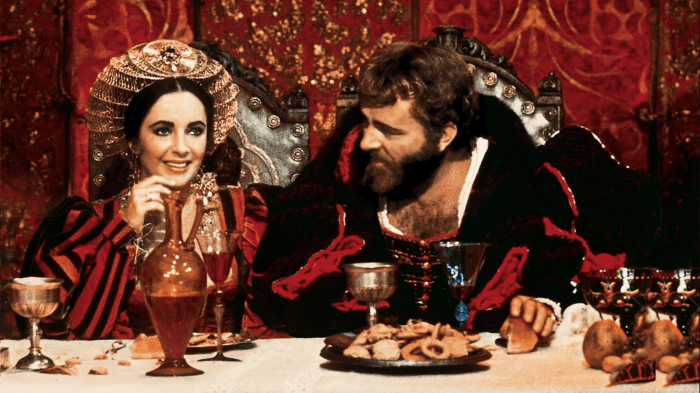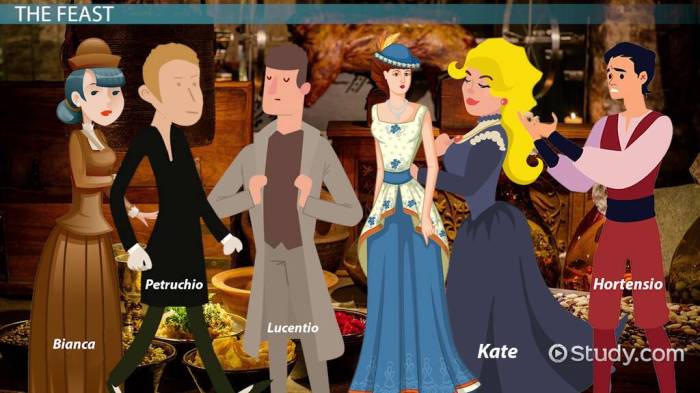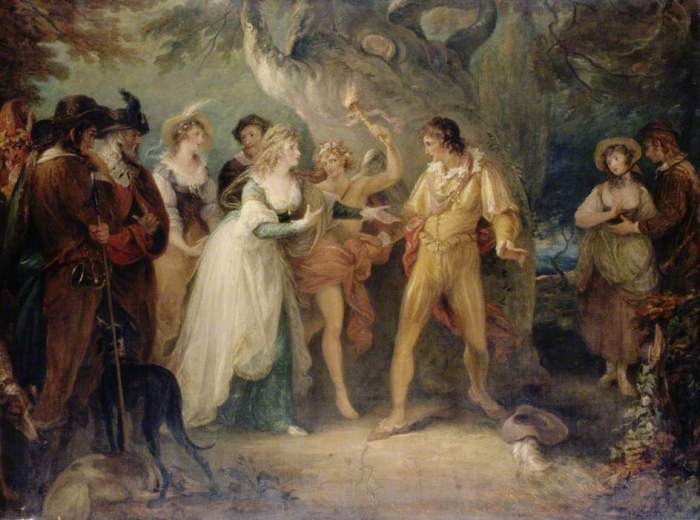Taming of the shrew act 5 – Delving into the captivating fifth act of Shakespeare’s “The Taming of the Shrew,” we embark on a journey where Petruchio’s unconventional methods collide with Katherina’s fiery spirit. This act serves as a culmination of the play’s themes, exploring gender roles, marriage, and the dynamics of power.
As Petruchio devises his strategies to tame his newlywed wife, we witness a battle of wills that unfolds with both humor and poignancy. Katherina’s transformation throughout the act becomes a testament to the complexities of love and submission.
Overview of Act 5

Act 5 of The Taming of the Shrewserves as a resolution to the play’s central conflict and provides a satisfying conclusion to the comedic events that have unfolded throughout the play.
The Wager and its Significance
The act opens with a wager between Petruchio and the other husbands, Hortensio and Lucentio. Petruchio claims that his wife, Katherine, is the most obedient and submissive of them all. To prove his point, he challenges the other husbands to test their wives’ obedience by ordering them to perform various tasks.
The wager sets the stage for the central conflict of the act, as the husbands attempt to prove the superiority of their wives’ obedience. This conflict ultimately culminates in a test of Katherine’s obedience, which she passes with flying colors, proving Petruchio’s point.
The Role of the Induction
The induction, which serves as a prologue to the play, establishes the wager and sets up the events of Act 5. In the induction, a group of noblemen trick a drunken tinker into believing that he is a wealthy lord.
As part of their trick, they arrange for him to marry Katherine, the shrewish daughter of Baptista Minola.
The induction creates a sense of uncertainty and confusion, as the audience is unsure of what is real and what is imagined. This uncertainty carries over into Act 5, as the husbands’ wager and Katherine’s obedience test play out.
Petruchio’s Taming Methods

Petruchio employs a variety of unorthodox and unconventional methods to tame Katherina. His approach is marked by a combination of psychological manipulation, physical deprivation, and public humiliation.
Petruchio’s methods are initially met with resistance and defiance from Katherina. However, over time, they prove to be effective in breaking down her spirit and molding her into a submissive and obedient wife.
Psychological Manipulation
Petruchio uses psychological manipulation to undermine Katherina’s sense of self and control. He constantly contradicts her, denies her basic needs, and isolates her from her family and friends.
By doing so, Petruchio creates a sense of uncertainty and insecurity in Katherina, making her more susceptible to his influence and control.
Physical Deprivation
Petruchio also employs physical deprivation as a means of taming Katherina. He keeps her awake for nights, denies her food and water, and forces her to wear uncomfortable clothing.
This physical deprivation weakens Katherina’s body and spirit, making her more vulnerable to Petruchio’s psychological manipulation.
Public Humiliation
Petruchio uses public humiliation as a final手段to break Katherina’s spirit. He publicly embarrasses her, mocks her, and makes her the object of ridicule.
This public humiliation destroys Katherina’s sense of dignity and self-worth, making her more willing to submit to Petruchio’s authority.
Comparison to Other Husbands
Petruchio’s taming methods are more extreme and coercive than those employed by the other husbands in the play.
Baptista Minola, Katherina’s father, uses a combination of persuasion and threats to convince Bianca to marry Lucentio. Hortensio, one of Bianca’s suitors, uses flattery and gifts to win her favor.
In contrast, Petruchio’s methods are based on domination and control. He uses psychological manipulation, physical deprivation, and public humiliation to break Katherina’s will and mold her into a submissive wife.
Katherina’s Transformation
Katherina’s transformation throughout Act 5 of “The Taming of the Shrew” is a pivotal moment in the play. Initially portrayed as a strong-willed and rebellious woman, Katherina undergoes a significant change in behavior, becoming obedient and submissive to her husband, Petruchio.Her
motivations for changing her behavior are complex. One key factor is Petruchio’s psychological manipulation and relentless “taming” tactics. Through sleep deprivation, food restriction, and constant verbal and physical abuse, Petruchio breaks down Katherina’s resistance and forces her to conform to his will.However,
it is important to note that Katherina’s transformation is not solely a result of external coercion. She also experiences a genuine change of heart. Petruchio’s relentless pursuit and unwavering belief in her potential gradually chip away at her defenses, allowing her to see him in a new light.The
significance of Katherina’s final speech is profound. In it, she publicly acknowledges her love and obedience to Petruchio, declaring that a wife’s duty is to serve her husband. This speech has been interpreted in various ways, with some critics seeing it as a reinforcement of patriarchal values, while others view it as a subversive critique of those same values.Ultimately,
Katherina’s transformation is a complex and multifaceted phenomenon that reflects the play’s exploration of gender roles, power dynamics, and the nature of marriage.
Katherina’s Motivations for Changing Her Behavior
Katherina’s motivations for changing her behavior are driven by both external and internal factors:
-
-*External Factors
Petruchio’s relentless psychological manipulation and “taming” tactics, including sleep deprivation, food restriction, and constant verbal and physical abuse, gradually break down Katherina’s resistance and force her to conform to his will.
-*Internal Factors
Despite the external coercion, Katherina also experiences a genuine change of heart. Petruchio’s unwavering belief in her potential and relentless pursuit gradually chip away at her defenses, allowing her to see him in a new light.
Thematic Exploration: Taming Of The Shrew Act 5

Act 5 of “The Taming of the Shrew” delves deeper into the play’s central themes, bringing them to a resolution. These themes include gender roles, marriage, and power dynamics, which are explored through the interactions between Petruchio and Katherina.
Gender Roles
The play challenges traditional gender roles by presenting a reversal of the expected power dynamics in marriage. Petruchio’s unconventional approach to taming Katherina forces her to confront her own agency and the societal expectations placed upon women.
Marriage
The play examines the complexities of marriage and the power struggles that can arise within it. Petruchio’s methods push the boundaries of what is considered acceptable behavior in a marriage, raising questions about the nature of love, submission, and control.
Power Dynamics
Act 5 explores the ways in which power is wielded and negotiated within relationships. Petruchio’s dominance over Katherina is challenged by her newfound understanding of her own worth, leading to a shift in their power balance.
Relevance to Contemporary Society
The play’s themes remain relevant to contemporary society, where debates about gender equality and the power dynamics in relationships continue. The play’s exploration of these issues provides insights into the ongoing struggle for equality and the challenges faced by individuals in navigating complex societal norms.
Dramatic Techniques
Shakespeare employs a variety of dramatic techniques in Act 5 to enhance the play’s impact and convey its themes. These techniques include humor, irony, and foreshadowing, each contributing to the play’s overall effectiveness.
Humor
Shakespeare uses humor throughout Act 5 to lighten the mood and provide comic relief. For example, Petruchio’s exaggerated and over-the-top behavior during the wager with the other gentlemen creates a humorous atmosphere. This humor helps to balance the play’s more serious moments and makes the characters more relatable and engaging.
The Taming of the Shrew’s Act 5 serves as a culmination of the play’s themes of gender roles and the power dynamics within marriage. While exploring these complex issues, why not indulge in a sweet treat? The cheba hut goo ball recipe offers a delectable escape from the play’s dramatic intensity.
As we return to Act 5, we find the resolution of the play’s central conflict, leaving us with a newfound appreciation for the nuances of human relationships.
Irony
Irony is another technique that Shakespeare employs in Act 5. For instance, Katherina’s initial resistance to Petruchio’s taming methods is ironic because she ultimately becomes a submissive and obedient wife. This irony highlights the play’s exploration of gender roles and the power dynamics between men and women.
Foreshadowing, Taming of the shrew act 5
Shakespeare also uses foreshadowing in Act 5 to hint at future events. For example, Katherina’s speech about the duties of a wife foreshadows her eventual transformation into a submissive and obedient woman. This foreshadowing helps to build suspense and anticipation, keeping the audience engaged and eager to see how the play will resolve.
Character Analysis

The characters in The Taming of the Shreware complex and multifaceted, each playing a vital role in the play’s themes and plot. Petruchio, Katherina, and the other husbands are particularly noteworthy, as their motivations, relationships, and actions contribute significantly to the play’s central conflict and resolution.
Petruchio
Petruchio is a wealthy and determined suitor who sets out to “tame” the shrewish Katherina. He is a master of manipulation and deception, using a variety of tactics to control and subdue her. However, despite his harsh methods, Petruchio is also shown to have a genuine affection for Katherina, and his actions are ultimately motivated by a desire to help her become a better person.
Katherina
Katherina is a strong-willed and independent woman who initially resists Petruchio’s attempts to control her. She is intelligent, witty, and quick-tempered, and she is not afraid to speak her mind. However, as the play progresses, Katherina gradually comes to accept Petruchio’s authority, and she eventually transforms into a more obedient and submissive wife.
The Other Husbands
The other husbands in the play, including Baptista, Hortensio, and Lucentio, serve as foils to Petruchio. They are all unsuccessful in their attempts to tame their wives, and they ultimately come to admire Petruchio’s methods. Their failure highlights the difficulty of controlling women, and it suggests that Petruchio’s success is due more to Katherina’s own willingness to change than to his own tactics.
| Character | Motivations | Relationships | Actions |
|---|---|---|---|
| Petruchio | To tame Katherina and make her a better person | Manipulative and controlling towards Katherina | Uses a variety of tactics to subdue Katherina |
| Katherina | To resist Petruchio’s attempts to control her | Initially resists Petruchio, but eventually accepts his authority | Transforms into a more obedient and submissive wife |
| Baptista | To find suitable husbands for his daughters | Admires Petruchio’s methods | Ultimately fails to tame his own wife |
| Hortensio | To marry Bianca | Unsuccessful in his attempts to tame Katherina | Eventually marries a widow |
| Lucentio | To marry Bianca | Unsuccessful in his attempts to tame Katherina | Eventually marries Bianca |
FAQ
What is the significance of the wager between Petruchio and the other husbands?
The wager serves as a catalyst for the events of Act 5, as Petruchio’s determination to prove his superiority over the other husbands drives his extreme methods of taming Katherina.
How does Katherina’s transformation impact the play’s themes?
Katherina’s transformation highlights the play’s exploration of gender roles and power dynamics. Her initial resistance and eventual submission to Petruchio’s authority challenge traditional societal norms.
What are the key dramatic techniques employed by Shakespeare in Act 5?
Shakespeare uses humor, irony, and foreshadowing to create a dynamic and engaging theatrical experience. These techniques enhance the play’s comedic elements while also hinting at the underlying tensions and conflicts.